What Is Crisis Management?
It’s a typical day at work; everything is running smoothly, and you’re checking off your tasks for the day like the boss social media manager you are when suddenly a crisis strikes. Campaigns and initiatives are thrown out the window, and each and every employee’s sole focus now is surviving the crisis, protecting the brand, and making it out alive (and with a job). Would your team have a crisis management plan and know what to do?

These days, word travels fast, and whether it’s a series of bad reviews, a company-wide misstep, natural disasters, or unwarranted trash talk from another entity, these crises can cause extreme damage to a business. It’s not even a matter of if but when a situation might arise. Luckily, there are social media crisis management plans you can have in place to ensure a better chance of success.
Whether you’re a small business, a big corporation, or even a political campaign, it’s important to be ready before disaster strikes. Businesses need to have a social media crisis management plan in place so that when disaster strikes, the organization is well-equipped to handle it. The core of crisis management revolves around communications. This means that it’s important for the entire company to be briefed and on board with whatever plan an organization chooses to follow.
Also, Check Out Tips for risk-free political social media campaigns
Why is Social Media for Crisis Management Important For Businesses?
As a social media manager or someone on a communications or marketing team within a brand, you might not think crisis management pertains to you. However, many might argue that these areas are the most crucial to making it out of a crisis successfully.
If a company is large enough to have its own crisis management department, most of those individuals tend to come from PR, advertising, or marketing backgrounds. This is because they are more likely to be trained in understanding target markets and demographics, are heavily involved with disseminating company messages, and have participated in extensive research regarding the psychology behind communications (a set of data that many CEOs aren’t as up-to-date on).
As a social media manager, you’re on the front lines of communication efforts with individual customers regularly. How you choose to manage communications in the midst of a social media crisis reflects upon the entire organization.
Over the years, as social media has become a standard for companies around the globe, we’ve seen both good and bad social media crisis management examples during difficult and controversial periods.
Here’s one of the good social media crisis examples: Starbucks
The Starbucks incident in Philadelphia involved Donte Robinson and Rashon Nelson in April 2018.
This example is sparked by a situation that developed at a Philadelphia Starbucks establishment. The two men involved, Robinson and Nelson were business partners and had arrived early at the Starbucks prior to a meeting on April 12. The men were waiting for a colleague before ordering. The Starbucks employee asked the men to leave because they hadn’t ordered anything yet. The men refused, and the employee decided to call the police to have the men removed from the store. The men refused again once police arrived and were eventually arrested and removed from the property. Witnesses commented that the men’s associate arrived as the arrest was being made.
Others in the Starbucks store immediately began documenting the situation and sharing it on social media. Many questioned why the two black men had this experience while white individuals who’d been in the same situation had never been challenged in this way. The action of offense taken by the Starbucks employee, plus the magnification of the event on social media, resulted in a social media crisis management situation on a national scale
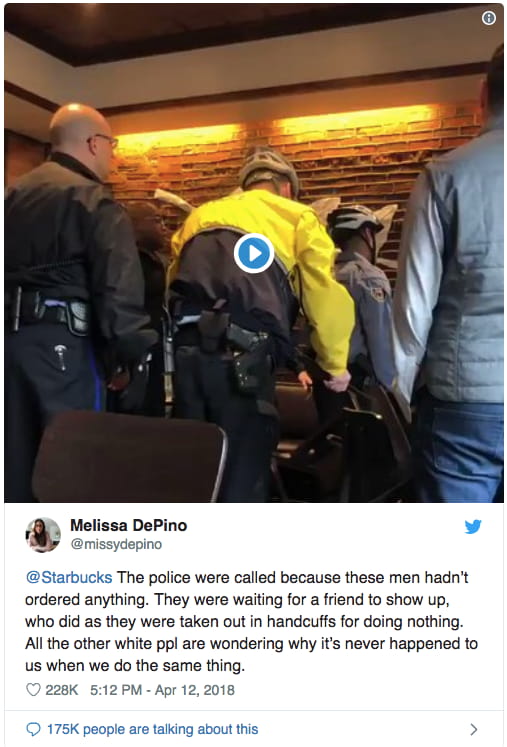
On April 14th, Starbucks released a primary statement via social media, apologizing to the two men and promising to review Starbucks’ policies and efforts to prevent a similar situation from happening again.
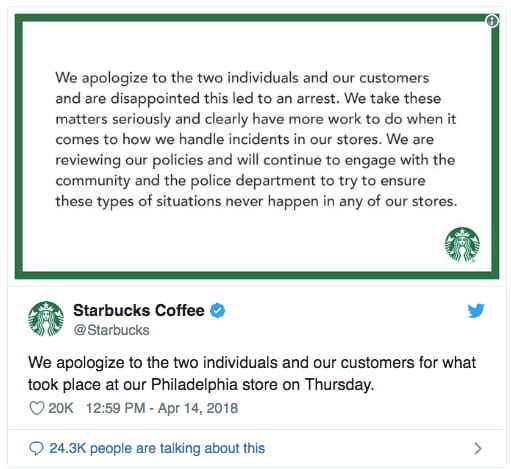
In a follow-up video message by Starbucks CEO Kevin Johnson, he expresses heartfelt concern, apology, and promise to be better, “In fact, I think the focus of fixing this — I own it. This is a management issue, and I am accountable to ensure we address the policy, the practice, and the training that led to this outcome.” Later, Starbucks would announce a company-wide afternoon shutdown where all employees participated in a “racial-bias” training as part of the company’s efforts to better educate their team on this matter.
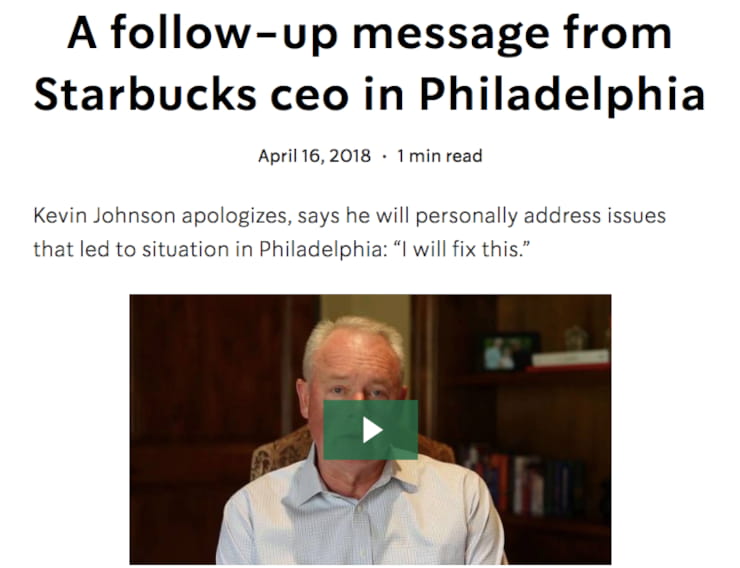
Here are a few reasons why Starbucks handled this social media crisis management situation well:
– Immediate apology and acceptance of responsibility regarding the situation. Straightforward and to the point, Starbucks did not try to shift any of the blame.
– Humanization and connection by way of a video message helped the public feel the sincerity and seriousness with which Starbucks was handling the issue.
– High-level transparency regarding the situation and the steps being taken.
– Starbucks displayed deeper thought and conversation into why the issue occurred and actionable ways to work towards improvement moving forward.
And here is a bad example of social media crisis management: United Airlines
The United Airlines Flight 3411 incident involving Dr. David Dao in April 2017:
This social media crisis example revolves around a situation that took place on a United Airlines flight. The flight had been overbooked, and 4 passengers needed to be re-booked on a different flight in order to allow 4 United employees on board to make it to their next shift. When no volunteers stepped forward, United chose 4 passengers. All complied except for Dr. David Dao, who said he needed to make it home that evening in order to attend to patients the following day. Dao, who had already boarded the plane, was ultimately forcefully removed by law enforcement. Videos show the scene as he was pulled from his seat, resulting in a fall where he hit and bloodied his head. Later, the footage shows him being dragged, limp, from the aircraft.
Many passengers filmed the incident and immediately shared to social media, tagging United with their complaints about Dao’s treatment. These posts gained traction very quickly amongst social users and news outlets. The first official statement made by United came late Sunday night after videos of the incident appeared on social media beginning around 7:30 pm:
“Flight 3411 from Chicago to Louisville was overbooked. After our team looked for volunteers, one customer refused to leave the aircraft voluntarily, and law enforcement was asked to come to the gate. We apologize for the overbook situation. Further details on the removed customer should be directed to authorities.”
From that moment onwards, the public began an increasingly aggressive response to United and its social media posts, demanding answers, creating memes, and “trolling” unrelated posts. The United social media team, however, responded with nearly identical, non-committal responses. Here is an example:
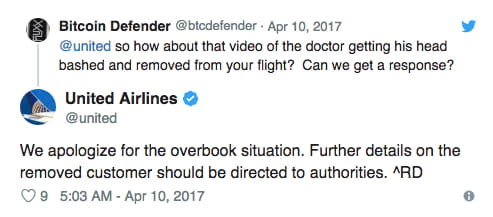
By this point, there was no mistaking that United should have been in the midst of the very definition of social media crisis management. However, it wasn’t until a little after noon on Monday (the day following) that an additional statement from United’s CEO was released:
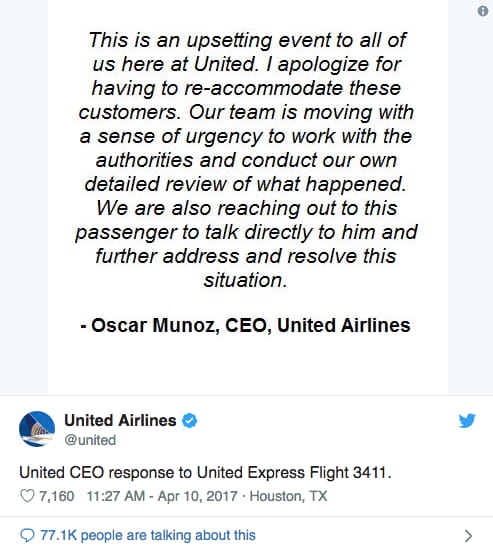
These communications, along with nearly all those that came after, contained a few similar themes: little to no responsibility accepted, lack of direct and sincere apology, lack of humanization, and blame placed on the passenger. It wasn’t until after the news had already become viral on social media that an additional, more direct statement was made by United’s CEO. This occurred on Tuesday, April 11th. Munoz was later even called to testify to Congress about the matter.
Eventually, David Dao and United reached a settlement, and several security guards were fired. Competing airlines used this to their advantage, making clever remarks on social media about how such an event would never happen within their companies and making further promises to better accommodate passengers.
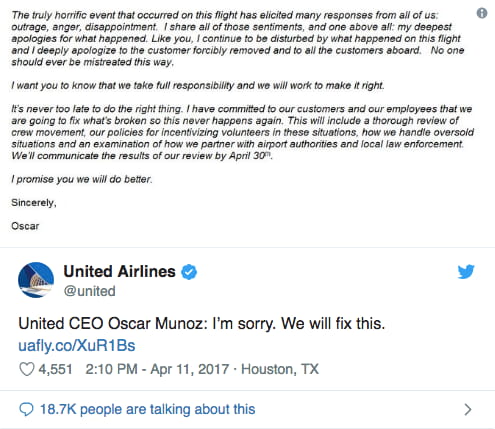
Here are a few reasons why United failed in this social media crisis management situation:
– The team started out on the right foot by asking those who shared the videos on social media for more information about the situation and reassuring passengers that they were looking into it. However, those were the last signs of human sensitivity and care United displayed until after the incident became viral on social media.
– United expressed total rejection of blame and responsibility for any part of the incident. In fact, they blamed it all on Dao.
– United only expressed sincere apology and responsibility once they realized the world was watching (and that the world was not pleased), which made it more challenging to establish trust that their apology was real.
– Minimal action was taken as a company to prove a bettering of training or process after the settlement was reached.
Basic Social Media Crisis Plan Steps to Ensure You’re Prepared:

Ideally, all social media managers and crisis management teams will handle social media crisis situations like Starbucks and not like United Airlines, right? You’d be surprised how quickly plans can take a turn for the worst without careful preparation, training, and strategy. We’ve rounded up a few foundational crisis management strategies to ensure your team is prepared.
Frontline Interactions:
Beyond in-person interactions, exchanges on social media, via a chat box, and the company’s “help” email are the most personal interactions your company has with customers. This is where we most often find out about previously unknown crises and continue to communicate with customers as the situation plays out.
In the initial discovery stages, the crisis managers should ask for more information and direct users off social media to send an email instead. Later on, once the official strategy and acceptable statements for this medium have been decided on, engaging with as many users as possible is important.
This shows company initiative and effort towards keeping the public in the loop. It’s imperative that these communications remain human and compassionate, yet neutral, while working to gather as much information as possible.
Written Statements, Speeches, and Video Messaging:
Releasing a statement is a crucial crisis management step to set a standard of acknowledgment, transparency, and intended action. While several written statements will be produced throughout the situation, creating a video message or taped speech can really help the public connect with the company in a more human way. The strategy behind these statements is adjusted based on the level of fault the company is at:
– At fault: If the crisis being managed is indisputably the business’ fault, this statement must express immediately an acceptance of responsibility for the situation, a promise to make corrections for the immediate damage, and a reassurance that measures will be taken to prevent further issues or change a policy altogether.
– Not at fault: If the instance in question is a crisis brought on by outside forces and the company is not at fault, an apology for the inconveniences the customers may have faced is appropriate. Beyond that, additional effort on behalf of the company to support customers during a difficult time goes a long way.
– Somewhere in between: The final situation is a gray zone where the company is one of several players at fault or could have done more to prevent damage. This zone is a precarious one where many companies fail to accurately assess their involvement – or perceived involvement – and mishandle the crisis. It’s important to accept responsibility for what was actually done and respond with compassion and action, whether it was 5% or 99% the business’ fault.
Rebound Campaigns:
Once the initial storm has passed, the next step of a crisis management strategy should involve a “rebound campaign”, or the beginning efforts to recover from the damage from the crisis. Depending on the situation, this can involve several tactics:
– Company-wide training, activities, charitable giving, etc., relating to the incident.
– Announcement of policy changes and additions
– New ongoing initiatives or charitable foundation
– Commercials/video series
– Print ads
– Digital ads
– Interactive event marketing
Timeliness for Social Media Managers During a Crisis
One of the most essential qualities to master within a crisis management plan is timeliness. No matter the type or severity of the crisis, someone, customers, news reporters, and the world will be demanding answers and statements. While it is important to take the needed time to ensure communications are accurate and strategic, waiting too long to respond can increase feelings of mistrust or neglect amongst the public.
Often, during a crisis, the business is alerted first via customers through social media or other direct messaging, like an email. The social media, customer relations, or other frontline communicators should be punctual in seeing and responding to these messages and then forwarding the information to the team.
If the crisis indeed is a company-wide one, rather than a routine customer complaint or something similar, it’s important to make a public statement. Releasing an initial public statement in 24 hours or less following a company crisis is ideal, while 48 hours is sometimes necessary if there are certain legal stipulations or details that must be confirmed prior to release.
As more information comes to light and company decisions are being made in regard to managing the crisis, additional communications should be shared as quickly as reasonably possible with the public.
Making timeliness a priority during the entire crisis management process is critical to maintaining the brand’s strength and transparency.
How to Prepare for Crisis Management: Team Roles and Responsibilities

During the typical day-to-day at your office, you’ll most likely have team members in charge of different areas, platforms, or types of communications. Many offices also have a range of autonomy for which team members are able to share certain communications without approval based on the brand guidelines. When a crisis strikes, however, it’s important that the entire company knows that the chain of command, roles and responsibilities, and types of communication allowed will shift.
If your company has a designated crisis management team, the chain of command for communications automatically will shift to the head of that team. In other scenarios, it will shift to the head of marketing or communications or to a small group of 2 or 3 executives in related roles. These individuals are the keepers of the crisis management plan and should follow it accordingly.
Within the communications and marketing departments, day-to-day activities should halt immediately, and crisis management mode should begin. Depending on the situation, this may look something like this:
Lower Level Associates (Social Media Assistants or Coordinators, Marketing Coordinators, PR Coordinators, etc.)
– Cease communication with the public via company accounts immediately.
– Ensure that automatically scheduled posts and communications are paused until the crisis has passed.
– Wait to engage in communication until the guidelines have been released by upper-level executives.
– Once guidelines have been released, follow them exactly, without deviation.
– Respond to your assigned area (sometimes based on social media platform, type of comments, etc.)
– Work accurately and efficiently.
– Keep note of any concerning findings or new developments and report them to leaders immediately.
Mid-Level Managers (Social Media Managers, Marketing Managers, PR Managers, etc.)
– Ensure all employees on the team have ceased company communication with the public and paused future scheduled posts.
– Gather as much information regarding the crisis situation as possible.
– Work with upper-level executives to ensure guidelines are reviewed, proofread, and cover all bases.
– Distribute and explain guidelines to employees
– Assign employees to individual tasks and areas of focus
– Once guidelines have been released, follow them exactly, without deviation.
– Work accurately and efficiently.
– Keep note of any concerning findings or new developments and report them to leaders immediately.
Upper-Level Managers/Executives
– Analyze crisis situation and confirm details with the legal team, law enforcement, or any other related officials
– Adjust crisis guidelines to reflect the situation accordingly.
– Work with upper-level executives to ensure guidelines are reviewed, proofread, and cover all bases.
– Once guidelines have been released, follow them exactly, without deviation.
– Work accurately and efficiently.
– Prepare to make statements, participate in interviews, or any other engagements as needed.
Dos and Don’ts for Social Media Managers
Ultimately, each crisis situation will entail different approaches to management and recovery. However, we’ve learned that the heart of good crisis management revolves around the same primary qualities: transparency, compassion, trust, and action. No matter what your business decides as its core crisis management plan, keep these general dos and don’ts in mind for a higher chance of success (or, in some cases, less damage) when managing company crises.
Do:
– Establish a plan well in advance of any crises.
– Make sure the roles and responsibilities of every department are well-defined.
– Have leadership and annexed branches of the company sign off and agree to follow the plan as directed.
– Admit fault for actual wrongs the company has made.
– Apologize sincerely.
– Present an intermediary solution and the promise of a long-term one (if needed).
– Be timely when communicating with the press and public.
Don’t:
– Ignore problems or potential crises
– Assume that executive leadership is experienced in crisis management.
– Make excuses for confirmed faults of the company.
– Release an insincere apology.
– Deviate from the established crisis management plan unless agreed upon by the team.
– Rush communications
– Send out any communications that haven’t been proofread and reviewed by at least 2 other crisis management team members.
